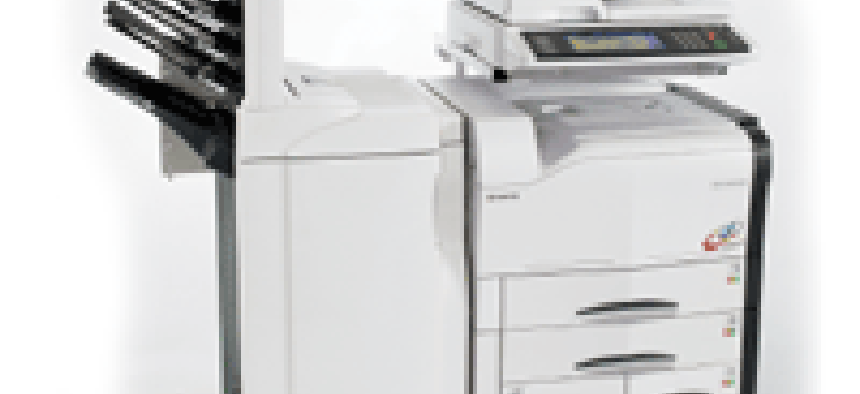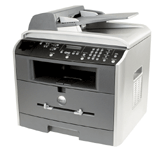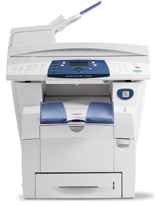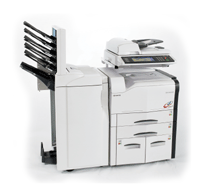Consolidation. It's a popular architecture strategy touted by government IT shops. But these days, consolidation has more to do with data centers than office centers. For many agencies, consolidation could easily apply to the fleet of copiers, printers, scanners and fax machines they maintain.All-in-one multifunction printers (or multifunction products, depending on whom you talk to) have been around a long time, but they've grown up significantly in recent years. What began as a home office printer with built-in copying, scanning and faxing capabilities has grown into an advanced network system that's like a Kinko's down your hall. Best of all these MFPs'some that are printers at their core, others that started out as copiers'stand to save your agency money.Why deploy an MFP when your current fleet of copiers and printers is serving you just fine (save for the ongoing maintenance and third-party contract it requires)? The fact is, the average large enterprise spends millions of dollars per year printing, copying, faxing, scanning and distributing information. In offices that use separate devices, the cost of human intervention (retrieving documents, clearing paper jams, installing new cartridges, etc.) can be a drain. Environmental costs, such as real estate, utilities and storage facilities, add to the total. Factor in document delivery and assembly costs (collation, folding, stapling and binding), courier or mailing services, and other preparation or delivery costs, and the price per document can be astoundingly high.An August study by IDC Corp. of Framingham, Mass., shows the possibility for significant savings from the use of networked MFPs versus discrete components. According to the study, a typical workgroup of 50 users incurs about $1,700 in monthly running hard costs'paper, toner, ink, etc. Swapping out multiple printers, copiers, scanners and fax machines for five MFPs and two digital printers can reduce hard costs by up to $200. Add in productivity savings of about $3,500, the study estimates, and the grand total amounts to monthly savings of up to $3,700 per workgroup.The good news is you can now shop for a networked MFP the way you might a single-purpose printer. MFPs haven't always been considered viable workgroup tools, because early generations suffered from a jack-of-all-trades, master-of-none reputation. But the current crop of third-generation MFPs offers high quality and reliability across the full spectrum of fax functions.[IMGCAP(2)]When browsing your favorite acquisition schedules for MFPs, look for a network-capable, laser-based system with a strong RISC engine and plenty of expandable memory. Consider single-pass technology, speeds of between 20 and 90 pages per minute of printing or copying, a standard or optional hard drive and a controller that can pass tasks seamlessly between the machine's various functions.In addition, any MFP worth your money should come with all or most of the following features.Advanced networking. Virtually all the manufacturers listed offer USB 1.1 or 2.0 and 10/100Base-T/TX Fast Ethernet compatibility with their MFPs. Some models offer 802.11b wireless connectivity. Others even offer Bluetooth connections for short-range, ad hoc tasks.All MFPs should support some version of the Simple Network Management Protocol to ensure that they can be configured and managed remotely. SNMP also allows supported devices to send messages indicating configuration and job status.Exceptional printing. An MFP should print as well as a dedicated printer. A standard print resolution of 600 by 600 dots per inch is perfectly adequate for text printing, although many manufacturers offer various interpolation techniques that boost the device's apparent resolution beyond 600 dpi.Most MFPs still print black-and-white text. But just as color has been catching on in network printers, it's also on the rise in MFPs. (Even in MFPs with monochrome laser engines, the copy and scan functions often offer color capability.) In addition, make sure your MFP comes with an array of fonts and standard print languages, such as HP PCL 6, HP PCL 5e, HP Postscript Level 3 emulation, direct PDF printing v1.3, XHTML-Print v0.95 and PML (Printer Management Language).[IMGCAP(3)]Network scan, fax and distribution capability. Network scanning enables efficient sharing of documents across and outside the network, thereby greatly increasing office productivity. In many cases, high-speed scanning of both sides of an original can be accomplished in a single pass. Scanned documents can be sent directly from the company's MFP to six different destinations: Send to Desktop, Send to E-mail (in TIFF or PDF file formats), Send to FTP (for transferring files to a server), Send to Group, Send to Fax and Send to URL.High-end MFPs, such as the HP Color LaserJet 9500 MFP and the Xerox WorkCentre Pro 35, offer similar scanning capabilities including support for Lightweight Directory Access Protocol. With LDAP, users can access an organization's network addresses by searching and displaying matching names from the MFP.A scan-to-e-mail feature can help reduce the costs and inefficiencies associated with mass faxing. But if you must fax, Canon, Sharp and other vendors offer optional Super G3 fax expansion kits, which enable their MFPs to serve as powerful fax machines with Internet fax transmission, single-pass duplex transmission, simultaneous fax transmission, direct-to-PC faxing and sequential broadcasting to as many as 500 locations. Other vendors, such as Lexmark, build such fax capabilities into their MFPs.The true test of an MFP is how seamlessly it switches between print, copy, scan and fax functions. This ability is largely de- pendent on the device's controller, which manages the various tasks. If in your preliminary tests, an MFP pauses between jobs or functions, or causes users to wait, consider buying a different unit.The chart starting on Page 96 is a mere sample of networked black-and-white and color laser-based MFPs. Where possible, we listed representative examples of each manufacturer's range of products; most sell a much larger range of MFPs, including very high-end document management and workflow systems priced in excess of $20,000. For these and others, check the vendors' Web sites for a complete list of their products.
Still, multifunction network printers can do it allDollars and centsThe true testJ.B. Miles writes from Honomu, Hawaii. E-mail him at jbmiles@starband.net.









